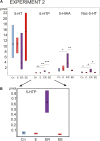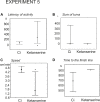The Role of Serotonin in the Influence of Intense Locomotion on the Behavior Under Uncertainty in the Mollusk Lymnaea stagnalis
- PMID: 32256385
- PMCID: PMC7091490
- DOI: 10.3389/fphys.2020.00221
The Role of Serotonin in the Influence of Intense Locomotion on the Behavior Under Uncertainty in the Mollusk Lymnaea stagnalis
Abstract
The role of serotonin in the immediate and delayed influence of physical exercise on brain functions has been intensively studied in mammals. Recently, immediate effects of intense locomotion on the decision-making under uncertainty were reported in the Great Pond snail, Lymnaea stagnalis (Korshunova et al., 2016). In this animal, serotonergic neurons control locomotion, and serotonin modulates many processes underlying behavior, including cognitive ones (memory and learning). Whether serotonin mediates the behavioral effects of intense locomotion in mollusks, as it does in vertebrates, remains unknown. Here, the delayed facilitating effects of intense locomotion on the decision-making in the novel environment are described in Lymnaea. Past exercise was found to alter the metabolism of serotonin, namely the content of serotonin precursor and its catabolites in the cerebral and pedal ganglia, as measured by high-performance liquid chromatography. The immediate and delayed effects of exercise on serotonin metabolism were different. Moreover, serotonin metabolism was regulated differently in different ganglia. Pharmacological manipulations of the serotonin content and receptor availability suggests that serotonin is likely to be responsible for the locomotor acceleration in the test of decision-making under uncertainty performed after exercise. However, the exercise-induced facilitation of decision-making (manifested in a reduced number of turns during the orienting behavior) cannot be attributed to the effects of serotonin.
Keywords: decision-making; effect of exercise on the brain; goal-directed locomotion; mollusks; serotonin.
Copyright © 2020 Aonuma, Mezheritskiy, Boldyshev, Totani, Vorontsov, Zakharov, Ito and Dyakonova.
Figures









Similar articles
-
Intense Locomotion Enhances Oviposition in the Freshwater Mollusc Lymnaea stagnalis: Cellular and Molecular Correlates.Biology (Basel). 2023 May 24;12(6):764. doi: 10.3390/biology12060764. Biology (Basel). 2023. PMID: 37372049 Free PMC article.
-
Exercise and the Brain: Lessons From Invertebrate Studies.Front Behav Neurosci. 2022 Jun 28;16:928093. doi: 10.3389/fnbeh.2022.928093. eCollection 2022. Front Behav Neurosci. 2022. PMID: 35836487 Free PMC article. Review.
-
Locomotor rhythms in the pond snail Lymnaea stagnalis: site of origin and neurotransmitter requirements.Acta Biol Hung. 2000;51(2-4):189-95. Acta Biol Hung. 2000. PMID: 11034143
-
Previous motor activity affects the transition from uncertainty to decision making in snails.J Exp Biol. 2016 Nov 15;219(Pt 22):3635-3641. doi: 10.1242/jeb.146837. Epub 2016 Sep 8. J Exp Biol. 2016. PMID: 27609760
-
[The endogenous opioid system tonically activates the locomotor neurons in the mollusk Lymnaea stagnalis].Zh Vyssh Nerv Deiat Im I P Pavlova. 1998 Jan-Feb;48(1):113-20. Zh Vyssh Nerv Deiat Im I P Pavlova. 1998. PMID: 9583170 Russian.
Cited by
-
Understanding the differential impacts of two antidepressants on locomotion of freshwater snails (Lymnaea stagnalis).Environ Sci Pollut Res Int. 2024 Feb;31(8):12406-12421. doi: 10.1007/s11356-024-31914-0. Epub 2024 Jan 17. Environ Sci Pollut Res Int. 2024. PMID: 38233708 Free PMC article.
-
Parental Serotonin Modulation Alters Monoamine Balance in Identified Neurons and Affects Locomotor Activity in Progeny of Lymnaea stagnalis (Mollusca: Gastropoda).Int J Mol Sci. 2025 Mar 10;26(6):2454. doi: 10.3390/ijms26062454. Int J Mol Sci. 2025. PMID: 40141098 Free PMC article.
-
PyRAT: An Open-Source Python Library for Animal Behavior Analysis.Front Neurosci. 2022 May 9;16:779106. doi: 10.3389/fnins.2022.779106. eCollection 2022. Front Neurosci. 2022. PMID: 35615283 Free PMC article.
-
Intense Locomotion Enhances Oviposition in the Freshwater Mollusc Lymnaea stagnalis: Cellular and Molecular Correlates.Biology (Basel). 2023 May 24;12(6):764. doi: 10.3390/biology12060764. Biology (Basel). 2023. PMID: 37372049 Free PMC article.
-
Exercise and the Brain: Lessons From Invertebrate Studies.Front Behav Neurosci. 2022 Jun 28;16:928093. doi: 10.3389/fnbeh.2022.928093. eCollection 2022. Front Behav Neurosci. 2022. PMID: 35836487 Free PMC article. Review.
References
LinkOut - more resources
Full Text Sources
Research Materials
Miscellaneous

